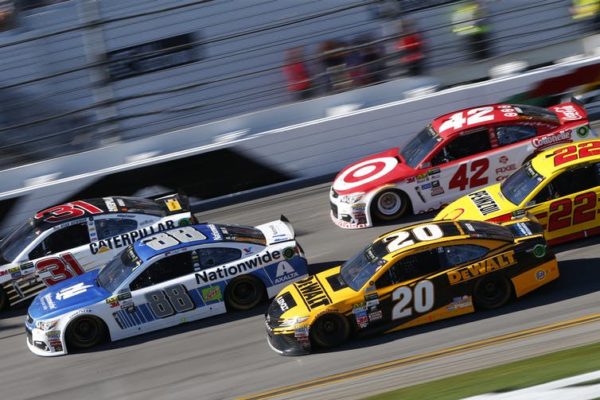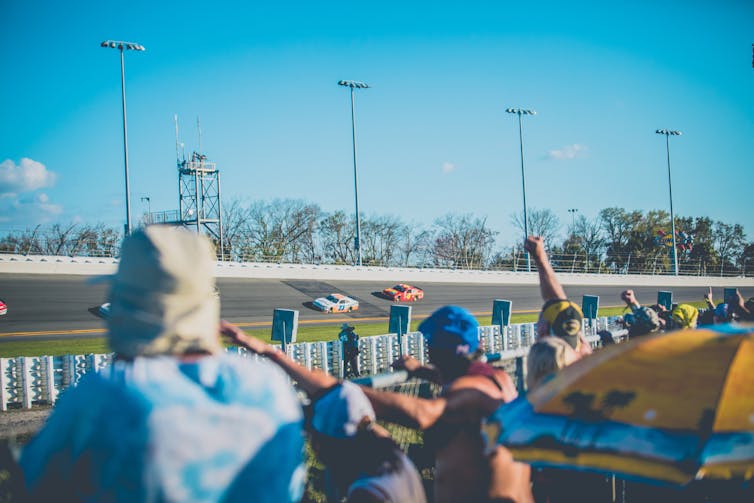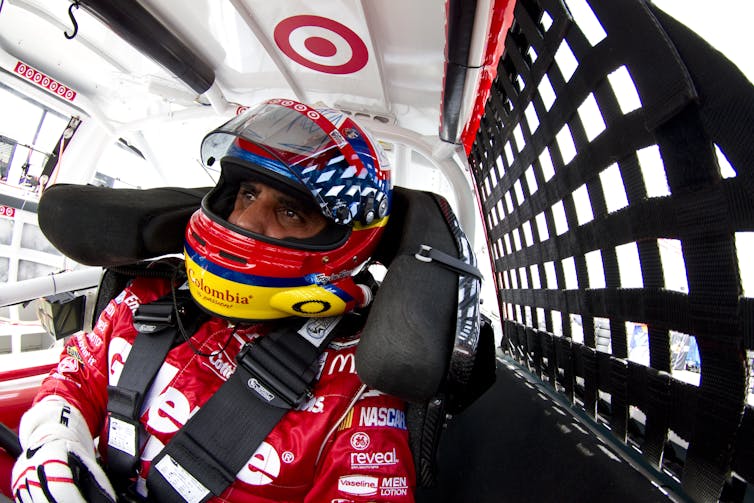NASCAR may be the fastest way to learn about physics

High speeds, the threat of dangerous crashes, the excitement of the crowd – and the laws of physics on full display. A physicist explains the science of NASCAR.
There’s just something thrilling about traveling at high speeds. Throughout history people have always pushed themselves to go faster, whether on foot, on horseback, on a boat or on a bicycle.
Nearly every weekend, today’s speed lovers can live vicariously by watching their favorite NASCAR drivers race around the track at death-defying speeds.
Maybe it’s the excitement in the crowd or maybe it’s the constant threat of danger that draws people to the sport. Or maybe its the feats of science and engineering that pull some spectators in. As a physicist, I love seeing all the physics principles on display during a NASCAR race.
Speed
NASCAR drivers travel at extremely high speeds, over 200 miles per hour. They accelerate so quickly that it takes them only around 3 to 3.5 seconds to go from zero to 60 mph. During this acceleration, the car must exert an average of 2,600 lbs of horizontal force against the track. This is comparable to the bite force of a large American crocodile or what it would take to lift a full-grown buffalo.
According to Einstein’s theory of special relativity, the faster you move through space, the slower your passage of time. So it’s fair to say that speed demon NASCAR drivers age a very tiny bit less than the rest of us. At the end of a 3.5 hour race, the drivers have aged about 0.5 nanoseconds less than the spectators who stayed still. If a driver raced nonstop at 200 mph for the next 50 years, he would age 70 microseconds less than the rest of us.
While NASCAR drivers are moving at incredibly fast speeds compared to the crowds in the stands, their speeds are small compared to what Einstein had in mind – like how fast light can travel, 670 million mph. The effect of relativity at the track is small, but it does exist.
The track
So how are drivers able to obtain these speeds?
As a car enters a turn, it naturally wants to continue in the direction it was originally going. To change direction to follow the curve of the oval-shaped track, a force must be applied.
The necessary force comes from the friction between the tires and the track. Friction is the connection between the two that prevents them from sliding against one another.
So for drivers it’s a balancing act – they want to keep the pedal to the metal, but they can’t go so fast on a curve that their speed overpowers the maneuvering ability provided by friction. Go too quickly and the friction may not be enough to prevent the car from continuing in its original direction and sliding straight into the wall. Slow down too much and you fall behind the competition.
 The banking of the track helps cars make those high-speed turns.
The banking of the track helps cars make those high-speed turns.Tim Trad/Unsplash, CC BY
The way the track is designed can help out here. The turns are banked, meaning they are higher on the outside of the track and lower toward the center. Part of the force of the road pushing up on the car – what physicists call the normal force – assists the frictional force of the tires and helps the car make it around the turn.
Banking in the turns at some of the fastest race tracks is comparable to the steepness of a playground slide. Banking at Richmond International Raceway allows cars to go approximately 1.3 times faster than they could without banking. Larger curves and higher banking, like those seen at Daytona and Talladega, allow the drivers to maintain a higher speed as they round those corners.
Power
Power is a measure of energy converted from one form to another in a set amount of time. In stock car racing, this conversion is from the chemical energy stored in gasoline to the kinetic energy of motion.
A NASCAR engine produces around 750 horsepower (560 kW), which exceeds a similar model street car that tops out around 300 horsepower. During a race, the power conversion of a NASCAR engines is about 500 times the power usage of the typical American household during the same period of time.
The cars’ power comes from burning gas as the engine rotates. The rotation of a NASCAR engine is 3.5 times faster than a standard street car and much more efficient, allowing it to combust more quickly and produce more power.
Collisions
With the high speed and power of stock cars come the risks of dangerous collisions. Some of the hardest crashes in NASCAR register around 80 G’s – that is, 80 times the acceleration of gravity that holds you to the planet. For perspective, amusement park rides top out around 6 G’s.
Safety elements try to extend the time, distance and area over which any collision takes place in an effort to lower these high forces. The principle is similar to the way gradually coming to a stop is less jarring than slamming on the brakes or the way a bed of nails spreads the weight of your body over a large area versus lying on a single nail.
SAFER barriers along the outside wall of the race track are made to crumple and dissipate a crash’s force over a large area. The front end of the car itself is also made to crumple, which extends the time of impact.
 Safety elements inside a NASCAR vehicle go way beyond the seatbelt you have in your car.
Safety elements inside a NASCAR vehicle go way beyond the seatbelt you have in your car.Action Sports Photography/Shutterstock.com
Carbon fiber seats in the car absorb more impact energy compared to aluminum seats. They stabilize the driver by wrapping around the rib cage and shoulders, and spread the impact force over a larger area.
A 5-point harness connects the driver to the car, once again spreading the area of impact. It also attaches the driver to the car, so he or she slows with the crumpling car rather than continuing forward at full speed until impact.
So next time you head to the track or tune in on TV, ponder some of the physics of NASCAR, as well as the contributions of scientists and engineers working behind the scenes to improve the speed, power and safety of the sport.
This article has been updated to correct the force on the track during a car’s acceleration.
Christine Helms, Assistant Professor of Physics, University of Richmond
Este artículo fue publicado originalmente en The Conversation. Lea el original. Photo: Action Sports Photography/Shutterstock.com


